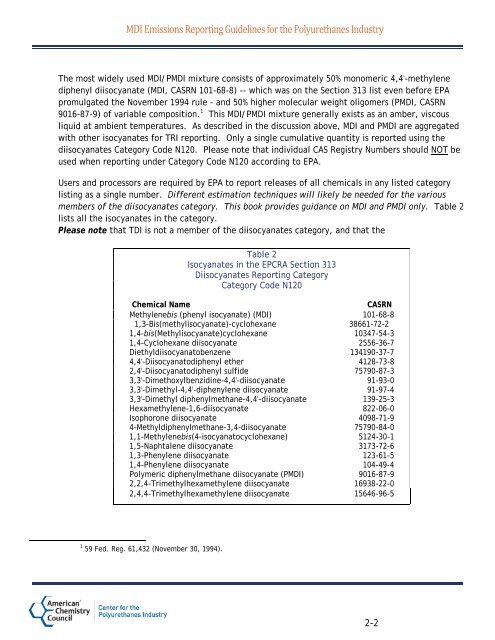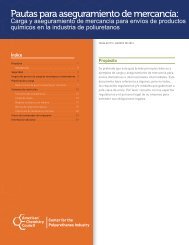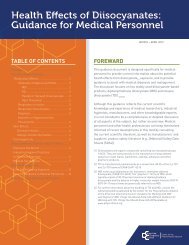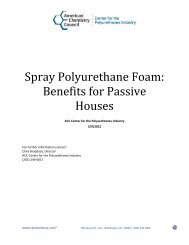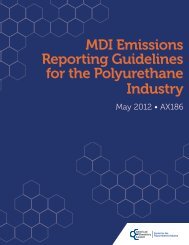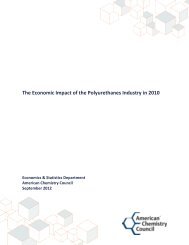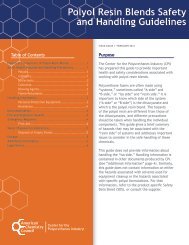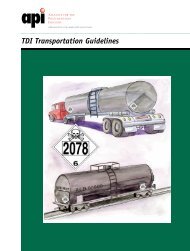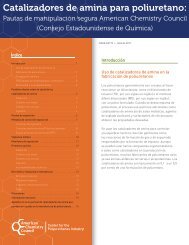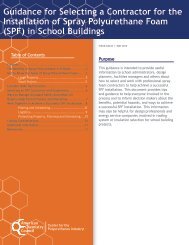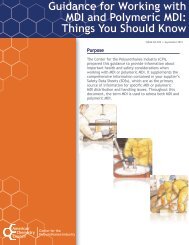MDI Emissions Reporting Guidelines for the ... - Polyurethanes
MDI Emissions Reporting Guidelines for the ... - Polyurethanes
MDI Emissions Reporting Guidelines for the ... - Polyurethanes
Create successful ePaper yourself
Turn your PDF publications into a flip-book with our unique Google optimized e-Paper software.
<strong>MDI</strong> <strong>Emissions</strong> <strong>Reporting</strong> <strong>Guidelines</strong> <strong>for</strong> <strong>the</strong> <strong>Polyurethanes</strong> Industry<br />
The most widely used <strong>MDI</strong>/P<strong>MDI</strong> mixture consists of approximately 50% monomeric 4,4'-methylene<br />
diphenyl diisocyanate (<strong>MDI</strong>, CASRN 101-68-8) -- which was on <strong>the</strong> Section 313 list even be<strong>for</strong>e EPA<br />
promulgated <strong>the</strong> November 1994 rule - and 50% higher molecular weight oligomers (P<strong>MDI</strong>, CASRN<br />
9016-87-9) of variable composition. 1 This <strong>MDI</strong>/P<strong>MDI</strong> mixture generally exists as an amber, viscous<br />
liquid at ambient temperatures. As described in <strong>the</strong> discussion above, <strong>MDI</strong> and P<strong>MDI</strong> are aggregated<br />
with o<strong>the</strong>r isocyanates <strong>for</strong> TRI reporting. Only a single cumulative quantity is reported using <strong>the</strong><br />
diisocyanates Category Code N120. Please note that individual CAS Registry Numbers should NOT be<br />
used when reporting under Category Code N120 according to EPA.<br />
Users and processors are required by EPA to report releases of all chemicals in any listed category<br />
listing as a single number. Different estimation techniques will likely be needed <strong>for</strong> <strong>the</strong> various<br />
members of <strong>the</strong> diisocyanates category. This book provides guidance on <strong>MDI</strong> and P<strong>MDI</strong> only. Table 2<br />
lists all <strong>the</strong> isocyanates in <strong>the</strong> category.<br />
Please note that TDI is not a member of <strong>the</strong> diisocyanates category, and that <strong>the</strong><br />
1 59 Fed. Reg. 61,432 (November 30, 1994).<br />
Table 2<br />
Isocyanates in <strong>the</strong> EPCRA Section 313<br />
Diisocyanates <strong>Reporting</strong> Category<br />
Category Code N120<br />
Chemical Name CASRN<br />
Methylenebis (phenyl isocyanate) (<strong>MDI</strong>) 101-68-8<br />
1,3-Bis(methylisocyanate)-cyclohexane 38661-72-2<br />
1,4-bis(Methylisocyanate)cyclohexane 10347-54-3<br />
1,4-Cyclohexane diisocyanate 2556-36-7<br />
Diethyldiisocyanatobenzene 134190-37-7<br />
4,4'-Diisocyanatodiphenyl e<strong>the</strong>r 4128-73-8<br />
2,4'-Diisocyanatodiphenyl sulfide 75790-87-3<br />
3,3'-Dimethoxylbenzidine-4,4'-diisocyanate 91-93-0<br />
3,3'-Dimethyl-4,4'-diphenylene diisocyanate 91-97-4<br />
3,3'-Dimethyl diphenylmethane-4,4'-diisocyanate 139-25-3<br />
Hexamethylene-1,6-diisocyanate 822-06-0<br />
Isophorone diisocyanate 4098-71-9<br />
4-Methyldiphenylmethane-3,4-diisocyanate 75790-84-0<br />
1,1-Methylenebis(4-isocyanatocyclohexane) 5124-30-1<br />
1,5-Naphtalene diisocyanate 3173-72-6<br />
1,3-Phenylene diisocyanate 123-61-5<br />
1,4-Phenylene diisocyanate 104-49-4<br />
Polymeric diphenylmethane diisocyanate (P<strong>MDI</strong>) 9016-87-9<br />
2,2,4-Trimethylhexamethylene diisocyanate 16938-22-0<br />
2,4,4-Trimethylhexamethylene diisocyanate 15646-96-5<br />
2-2


